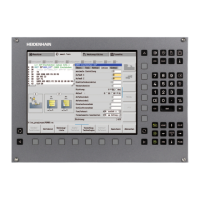1782 HEIDENHAIN Technical Manual MANUALplus 620
Status of the RTS
line
When using RTS/CTS hardware handshaking, two control lines in the RS-232
cable are used to signalize readiness to send data to or receive data from the
other side. If the control wants to send data to the peripheral device, and the
device is ready to receive data, then the RTS line is set to HIGH. The peripheral
device sets the CTS line to HIGH in order to signalize its readiness to receive
data from the control.
In the idle state, the control normally provides a HIGH level on the RTS line.
You can change the idle state of the RTS line from HIGH to LOW level by
setting the optional MP_rtsLow parameter.
MP_rtsLow
Idle state of the RTS line
Available from NCK software version: 597 110-03.
Format: Selection menu
Selection: TRUE
The idle state of the RTS line is logical LOW
FALSE
(default) The idle state of the RTS line is logical HIGH
Default: No entry, value optional
Access: LEVEL2
Reaction: NOTHING
Behavior after
receipt of ETX
With the optional parameter MP_noEotAfterEtx you define the behavior of
the control after reception of the ETX control character. ETX signalizes the end
of input for software handshaking. Normally the control automatically sends an
EOT control character after reception of an ETX control character (EOT= End
Of Transmission). Set the MP_noEotAfterEtx parameter to the value TRUE in
order to deactivate transmission of the EOT character.
MP_noEotAfterEtx
Defines the behavior after reception of an ETX control character
Available from NCK software version: 597 110-03.
Format: Selection menu
Selection: TRUE
No EOT control character is sent after reception of an ETX
control character.
FALSE
(default) The control sends an EOT control character after
reception of an ETX control character.
Default: Value optional, no entry
Access: LEVEL2
Reaction: NOTHING

